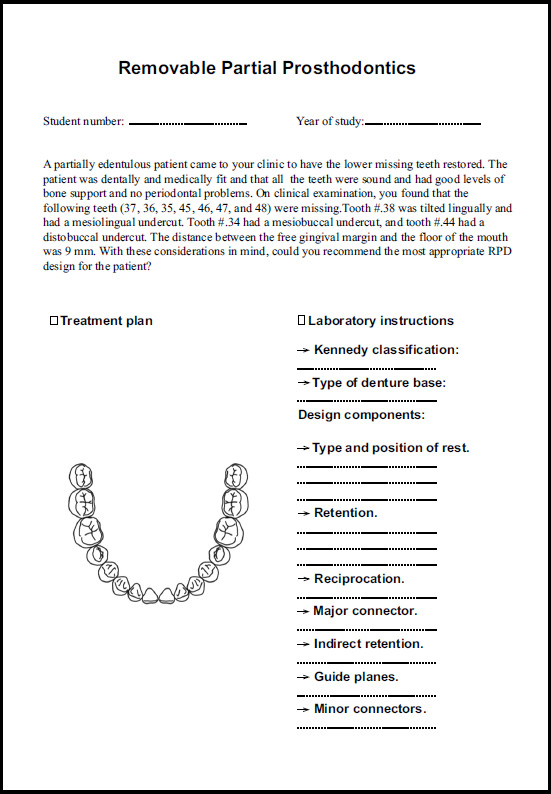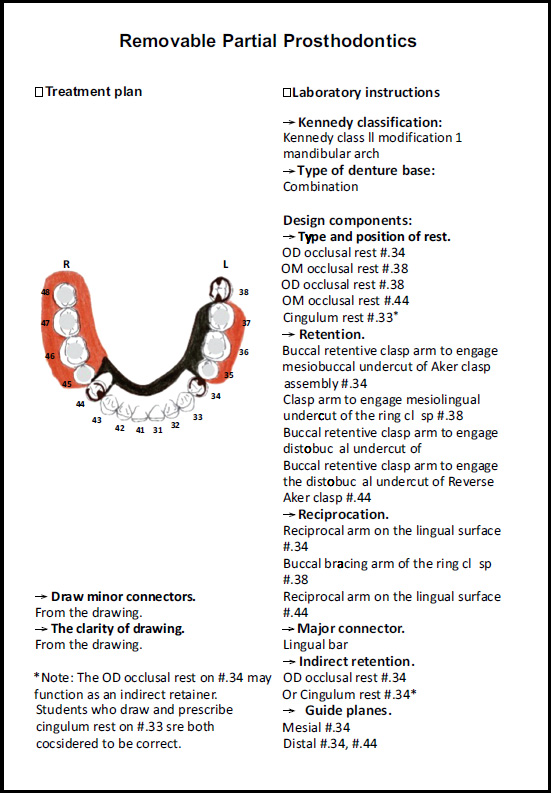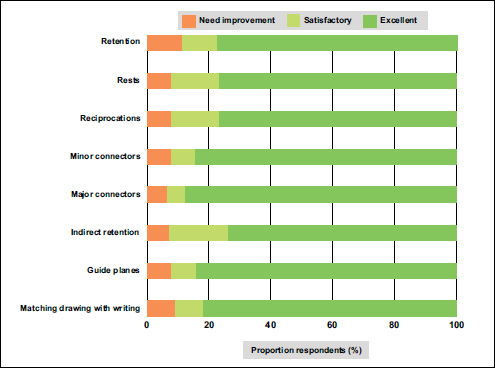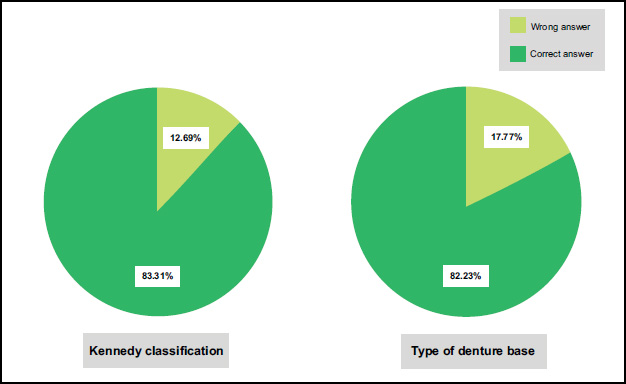All published articles of this journal are available on ScienceDirect.
Assessment of Removable Partial Denture Design Skills among Undergraduate Dental Students: A Cross-sectional Study
Abstract
Background
There is a growing need for skilled dentists who can offer high-quality treatment for patients who need sophisticated Removable Partial Dentures (RPDs). Therefore, it is essential for undergraduate training programs to ensure that students have the requisite skills and competencies to meet this demand. Aim: This study was conducted to assess the skills of undergraduate dental students in producing clinically effective RPD designs.
Materials and Methods
A clinical scenario for a patient who required RPD was created. Over the period of two consecutive academic years, from 2022 to 2024, fourth- and sixth-year undergraduate students were invited to participate in the study. The students were instructed to draw the most appropriate design for the case. An answer sheet was prepared to guide the evaluation of the students’ skills in designing RPD frameworks. Descriptive and inferential statistical analyses were computed to assess the distribution of the RPD design scores, and the statistical significance was set at 0.05. The Mann–Whitney U test was used to compare score differences between groups.
Results
A total of 197 undergraduate dental students participated in this study. The descriptive analysis of the RPD design components demonstrated that the majority of students received excellent or satisfactory scores for most RPD design components, with the exception of indirect retention, major connectors, and matching the drawing with writing, where students received ratings that needed improvement, which were 15%, 10%, and 7%, respectively. Female students received higher overall scores than male students, with a statistically significant difference between the two groups (p < 0.001). Moreover, fourth-year students significantly outperformed sixth-year students in their overall scores (p = 0.007).
Conclusion
The undergraduate students were found to have the knowledge and fundamental skills necessary to create basic, clinically effective RPDs. However, students need to study RPD design principles consistently throughout their clinical years. This can be accomplished using contemporary pedagogies for instruction on removable prosthodontics.
1. INTRODUCTION
The restoration of lost teeth is an ongoing need that patients demand as they age [1]. The overall pattern of tooth loss is expected to change as the prevalence of complete edentulism decreases, while the demand for restoring partly missing teeth is anticipated to rise [2]. Although dental implants are being increasingly accepted, Removable Partial Dentures (RPDs) continue to be a suitable treatment choice for patients with missing teeth [3]. RPDs are used for rehabilitation based on the following indicators: patient apprehension toward surgery, anatomical limitations, the need to restore damaged hard and soft tissues, budgetary constraints, and the presence of extensive edentulous areas [1, 2]. These factors may warrant the use of RPDs even when treatment alternatives are available [4].
RPD production involves a multitude of clinical and laboratory procedures [1, 2]. The design of an RPD framework is crucial for ensuring the creation of a well-constructed RPD. RPD design is challenging because of each patient’s unique oral and dental parameters, which necessitate specialized designs that account for biomechanical and biological factors, aesthetic demands, patient preferences, and durability [5]. An accurate RPD design relies on a thorough understanding of the indications and functions of each component of the RPD. When building an RPD, it is important to keep three factors in mind: support, retention, and stability [1, 2].
Designing the denture framework for an effective RPD requires accurate treatment planning and dedication to precision. Using a poorly designed and produced prosthesis can lead to harmful consequences for oral tissues, including dental plaque accumulation, food stagnation, and excessive pressure on the underlying residual ridge and abutment teeth [6]. These may result in gingivitis, dental caries, periodontal issues, and excessive bone loss over time. Therefore, it is the duty of dental educators to provide students with the expertise and professional traits necessary to effectively address the oral healthcare demands of the community [7, 8]. Insufficient clarifications and discrepancies in teaching removable prosthodontics may lead to misconceptions among dental graduates when treating patients in independent clinical settings, potentially leading to subpar patient care [9].
Dental schools worldwide consistently assess their educational programs and pedagogical approaches regarding removable prosthodontics to guarantee the inclusion of contemporary evidence-based procedures and to address the oral health requirements of the population [7, 8, 10-12]. Despite variations in learning standards, clinical requirements, and the clinical competencies achieved by undergraduate students, studies have focused on verifying whether students have acquired fundamental clinical competencies by completing their undergraduate training [7, 8].
Prior investigations have revealed a lack of adequate instruction and training on RPDs for dentistry students [9-13]. This phenomenon may be attributed to a dearth of or restricted experiences with RPD cases, insufficient competent staff who specialize in RPDs, time constraints in the course of study, and a scarcity of resources [8-12]. Curriculum-related time constraints have been brought up as issues faced when teaching an RPD course. In dental colleges in Saudi Arabia, the BDS curriculum typically spans six years, followed by a one-year internship [14]. The curriculum on RPDs is aimed at providing graduates with the skills and knowledge required to meet global benchmarks. The study of preclinical removable prosthodontics often starts in the fourth year of dental school. This course focuses heavily on developing students’ laboratory skills, understanding of RPD components, and ability to create designs for various RPD scenarios (introductory level). Students engage in theoretical lectures, didactic practical sessions, tutorials, and foundational laboratory exercises focused on removable partial and total denture treatments. In the fifth year, the curriculum primarily focuses on the clinical aspects and current practices involved in the management of partially edentulous patients. Theoretical lectures, tutorials, and clinical sessions that specifically address the clinical facets of training are conducted. Additionally, students engage in cooperative work in small groups, carrying out both complete and partial denture treatments. These activities are closely monitored by supervisors and provide students with practical experience in managing various clinical situations. Students at this level engage in chairside teaching, interactive sessions, case study discussions, and Self-Directed Learning (SDL) presentations. They work in small groups and on supervised treatments, dedicating a significant amount of time to these activities. They are required to manage a minimum of two cases, including RPDs with a cobalt-chromium (Co-Cr) framework and three cases involving acrylic RPDs [13].
Prior research has not examined the ability of undergraduate students to generate optimal RPD designs. Further, few studies have compared the performance of undergraduate students who recently completed their preclinical RPD course with the performance of those who had clinical experience and managed a number of clinical cases. There is also a lack of research on gender differences in undergraduate students’ performance.
Therefore, this study was conducted to examine the performance of undergraduate students in producing a detailed RPD design and to compare the scores for the produced RPD designs according to gender and year of study. The researchers hypothesized that gender would have no effect on the RPD design scores and that sixth-year students would receive higher scores than fourth-year students, according to the key answer sheet.
2. MATERIALS AND METHODS
The research bioethics and medical committees of Umm Al-Qura University granted ethical approval for this study (approval no. HAPO-02-K-012-2023-05-1622).
This study included fourth-year and sixth-year undergraduate students studying at Umm Al Qura University over two consecutive academic years, from 2022 to 2024. The fourth-year students were chosen because they had completed their preclinical removable prosthodontics course and practical sessions. The sixth-year students were invited because they had already gained clinical experience and training through their clinical removable prosthodontics courses and clinical sessions.

The worksheet used in the study.
A worksheet with a written clinical scenario for a partial denture case requiring RPDs was created. The students were instructed to draw the most appropriate design for the case and write down the design component instructions in the space provided (Fig. 1). Due to the subjective nature of partial denture design and the lack of a universally accepted RPD design, the creation of a definitive evaluation sheet for design assessment was not feasible. The authors who are clinical teachers in the removable prosthodontics department at Umm Al-Qura University) generated what we believed to be the most clinically effective design for the proposed scenario in consensus with the available evidence and references [1, 2] (Fig. 2).

The answer sheet created for the removable partial denture design case.
Data were collected during the last session of the removable prosthodontics course of each academic year. The authors explained the purpose of the study to the students and obtained the participants’ consent. Half an hour was given to each student to complete the worksheet. The designs provided by the dental students were compared to the criteria mentioned in the key answer sheet. Four evaluators (AG, SN, AA, and HE) independently assessed and rectified the completed RPD designs and compared the responses using a key answer sheet prepared by the authors. Based on the scores of the evaluators, the average score for each submitted design was calculated. Subsequently, AM and RS reviewed the assessment sheets to ensure that there were no errors in the rectification process.
The submitted designs were evaluated based on their efficacy in delivering optimal care to preserve oral health, along with a consideration of the basic biomechanical principles of RPD design. The designs were compared to a design created by the investigators, as given in the answer sheet. A grading sheet was also created based on 10 criteria given in the work of Johnson and Wildgoose (2011) [9] and textbooks [1, 2], the Kennedy classification, the type of denture base, the type and position of direct retainers, the type and position of rest, the minor connector, the reciprocation, the guide plane, the type and position of indirect retainer, the major connector type, and the ability to match the drawing to the written description. Each RPD component received a score ranging from 0 to 6, denoting that it was excellent (6–5), acceptable (4–3), or needed improvement (2–0). The Kennedy classification and type of denture base were given a score of 1 for a correct answer and 0 for a wrong answer or no answer.
3. DATA ANALYSIS
The data obtained from the RPD design evaluations were analyzed using IBM’s Statistical Package for the Social Sciences (SPSS) program for Windows v28 (SPSS Inc., Chicago, IL, USA). Descriptive statistics and frequency analyses were computed to assess the distribution of RPD design scores. The Mann–Whitney U test was used to compare score differences between groups. P-value < 0.05 was considered significant.
| Variable | N (%) |
|---|---|
| Gender | |
| Male | 92 (46.7) |
| Female | 105 (53.3) |
| Year of Study | |
| Fourth-year dental student | 104 (52.8) |
| Sixth-year dental student | 93 (47.2) |
4. RESULTS
4.1. Demographics
A total of 201 undergraduate students were invited to participate in the study, of which 197 students accepted to participate. The response rate was 98%. The sample consisted of N = 104 fourth-year students and N = 93 sixth-year students, with a slightly higher proportion of female participants (N = 105) than male (N = 92) (Table 1).

The distribution of students’ scores for each RPD design criterion.

The proportions of correct answers for the Kennedy classification and denture base questions.
| RPD Design Component | Male | Female | p-value |
|---|---|---|---|
| Mean Rank | Mean Rank | ||
| Retention | 93.55 | 103.77 | 0.163 |
| Type and position of rests | 88.58 | 108.13 | 0.006 * |
| Reciprocation | 98.16 | 99.74 | 0.733 |
| Guide plane | 95.38 | 102.17 | 0.169 |
| Indirect retention | 89.91 | 106.97 | 0.008 * |
| Minor connectors | 92.32 | 104.86 | 0.008 * |
| Type of major connector | 92.87 | 104.37 | 0.013 * |
| Matching drawing with a written design | 91.05 | 105.97 | 0.045 * |
| Overall score | 80.39 | 115.30 | <0.001 * |
4.2. Scores of Dental Students for Each RPD Design Criterion
The descriptive analysis showed that the majority of dental students received excellent or satisfactory scores for the majority of RPD design components, with the exception of indirect retention, major connectors, and matching the drawing with writing, while 15%, 10%, and 7% of the students, respectively, received ratings that needed improvement (Fig. 3). In addition, approximately 87.31% of the students answered the Kennedy classification question correctly, and 82.23% of the students provided a correct answer for the type of denture base (Fig. 4).
4.3. Comparison of Dental Students’ Scores According to Gender
The findings of the study revealed that female students received higher overall scores than male students, with a statistically significant difference between the two groups (U = 3118.000, p < 0.001). Female students also obtained significantly higher scores in several RPD components than male students, as mentioned in Table 2. The primary differences were found in the position of rest, the position of indirect retention, drawing minor connectors, selecting the type of major connector, and matching the drawing with the prescribed design. No significant relationship was found between gender and the answers to the Kennedy classification and denture base questions (p = 0.064 and p = 0.321, respectively).
4.4. Comparison of Dental Students’ Scores According to Level of Study
The results revealed that fourth-year students significantly outperformed sixth-year students in their overall scores (U = 3763.500, p = 0.007). Moreover, the fourth-year students received higher scores than the sixth-year students in the majority of RPD design components (Table 3). However, no significant differences were found between the RPD design component scores of the two groups, except in drawing indirect retention, with the fourth-year students receiving significantly higher scores than the sixth-year students (p = 0.001). No significant relationship was found in terms of the level of study and the answers to the Kennedy classification and denture base questions between the students (p = 0.932 and p = 0.093, respectively).
5. DISCUSSION
Regarding the initial hypothesis of this study, the findings showed that the students successfully created designs that closely resembled the given designs for the proposed clinical scenario, except for some particular areas that needed enhancement. The obtained RPD design scores differed for certain design aspects based on the gender and level of study of the students. However, the second and third hypotheses established for the project were not fulfilled, and none of the assumed notions about the final-year students’ comprehension of RPD design were supported.
A significant proportion of undergraduate students had excellent or satisfactory scores for most of the components related to RPD design. However, several aspects needed improvement, including indirect retention, the type of major connector, and matching the drawing with the prescribed design. The scenario used in this study was a Kennedy class II modification 1 mandibular arch. Typically, indirect retainer components in the form of occlusal rest or cingulum rest are needed to provide the best leverage advantage against dislodgement around the fulcrum line. About 15% of the students failed to prescribe such components in the clinical scenario, and around 10% of the students did not provide the most clinically effective major connector based on oral and dental situations. A possible justification for these results is that undergraduate students may find the study of indirect retainers in RPD difficult, as they must possess critical thinking skills and knowledge about the biomechanics involved in RPD design to comprehend this subject. Indirect retainers are of utmost importance in ensuring the stability and retention of RPDs [1, 2]. Similarly, the subject of major connectors is complex. There are multiple types of major connectors, each with distinct indicators and design standards [1, 2]. Moreover, acquiring an in-depth understanding of the nuances of each design may be daunting.
Another aspect that required improvement was matching the drawing with the prescribed writing. Approximately 7% of the students’ drawings were unclear, but it is uncertain whether this problem was primarily related to the educational skills or hand skills of the students. A previous study found that including written statements with drawn instructions provided accurate data about the type of rest, connectors, and clasp position [15]. This could improve communication between a dentist and a dental laboratory, as a dental technician’s primary responsibility is to construct an RPD framework in accordance with the specific requirements given by a dentist on a laboratory prescription. Hence, the inclusion of a precise illustration for RPD design in the dental laboratory prescription is an essential skill that students must acquire and receive sufficient instruction for. This skill will enhance the precision and details of the students, allowing them to convey the exact requirements and expectations and thus minimize the possibility of mistakes and misunderstandings [15]. Prior studies have reported that RPD design prescriptions for dental labs do not fulfill the necessary criteria, resulting in imprecise fitting and necessitating several modifications and remakes, a potentially time-consuming and expensive process for both the patient and the dental office [16-18].
Among the samples examined in the current study, the majority of dental students achieved excellent scores for most RPD design components. Numerous factors could account for these scores. The first is the availability of an
| RPD Design Component | Fourth-year Dental Students | Sixth-year Dental Students | p-value |
|---|---|---|---|
| Mean Rank | Mean Rank | ||
| Retention | 99.31 | 98.65 | 0.928 |
| Rests | 103.80 | 93.63 | 0.151 |
| Reciprocation | 100.65 | 97.16 | 0.450 |
| Guide plane | 101.06 | 96.70 | 0.378 |
| Indirect retention | 94.00 | 104.60 | 0.101 |
| Minor connectors | 106.83 | 90.24 | 0.001 * |
| Major connectors | 102.91 | 94.63 | 0.073 |
| Matching drawing with a written design | 104.97 | 92.33 | 0.093 |
| Overall score | 109.31 | 87.47 | 0.007 * |
appropriate educational program for removable prosthodontics and the presence of qualified faculty [13]. The second is the large number of partially edentulous patients who generally visit the dental hospital seeking treatment. This enabled the students to select the indicated cases for metallic RPDs. The third is the availability of dental technicians in the dental school, which makes it easy to communicate with the dental laboratory whenever needed [19].
One of the intriguing results of this study was that female students received higher overall scores than male students, with a statistically significant difference between the two groups. Little research has been conducted in the dentistry field to evaluate this outcome. Nevertheless, this tendency could be explained by some factors associated with dental courses and other academic programs, such as the study habits and attitudes of the students. Studies have reported that female students often have more consistent study habits and a higher degree of devotion to their academic work than male students do. They also have a propensity for organization and perseverance, which may lead to elevated academic performance [20]. In addition, women often engage actively in classroom discussions and are more inclined to seek assistance when necessary, resulting in enhanced comprehension and long-term memory of the course content [20]. Additionally, women may experience different social pressures and intrinsic motivations that drive them to achieve high academic performance standards [21].
It was surprising to find that the fourth-year students significantly outperformed the sixth-year students in their overall scores for the RPD design. This finding contradicts the results of prior research conducted by Batak et al. (2019), which showed that the average RPD design skill score of clinically experienced dental students was significantly greater than that of inexperienced dental students [22]. However, a different study revealed that students with clinical experience did not demonstrate any more proficiency or self-assurance in their ability to design RPDs than students who had just completed laboratory training and had no previous clinical experience [9]. One possible explanation for this could be the absence of a comprehensive review of RPD design principles in the clinical year curriculum. Furthermore, the amount of time dedicated to instructing students on the practical and technical components of fabricating RPD appliances has gradually decreased to align with an anticipated decline in the need for such equipment, which has not really occurred [9]. The current transition to a curriculum focused on implants and fixed prosthodontic topics is causing a decline in expertise in both the clinical and technical aspects of this field.
With the emergence of mobile health applications on smartphones and artificial intelligence, it might be useful to incorporate these technologies in dentistry to help dental students and practitioners provide an accurate diagnosis and treatment planning as well as a better treatment outcome of dental cases [23-25]. A recent study compared the undergraduate students' performance in designing the RPD with and without the use of AI-powered computer software. Students enjoyed using the software with automated feedback and gamification strategies in RPD planning, which improved their final grades. Their findings denoted that the addition of this technology would be useful if added as an adjunct for teaching undergraduate students [26].
While this study presented compelling data on undergraduate students’ proficiency in developing RPD designs, it also had a few limitations. First, the study was carried out at a single dentistry school, which restricts the generalizability of the results. Dental schools with varying curricula, clinical and practical training, demographics, and educational environments may provide disparate outcomes. Future studies should be conducted in multiple dental schools to ensure the generalizability of the results. Second, the study sample included only undergraduate students, which may limit the potential to track changes or clinical developments over time after completion of an undergraduate degree. Future investigations could involve interns, postgraduate students, and general practitioners in comparison with artificial intelligence software to compare the produced designs.
CONCLUSION
From the present findings of this study, it could be concluded that the undergraduate dental students had the knowledge and fundamental skills necessary to create basic, effective RPDs in terms of planning, designing, and drawing the components. This might be attributed to the appropriate undergraduate curriculum that incorporates the theoretical and preclinical sessions that equip students with the necessary skills in accordance with the prosthodontic principles, concepts, and practices of the Academy of Prosthodontics.
However, it is necessary for students to study RPD design principles consistently throughout their clinical years. This can be accomplished through the use of contemporary pedagogies for instruction on removable prosthodontics.
AUTHORS’ CONTRIBUTION
A.A.: Study conception and design; S.N., A.F., and H.E.: Data collection; A.M.: Methodology; R.S.: Draft manuscript. All authors reviewed the results and approved the final version of the manuscript.
LIST OF ABBREVIATIONS
| RPDs | = Removable Partial Dentures |
| SDL | = Self Directed Learning |
| Co-Cr | = Cobalt-Chromium |
ETHICS APPROVAL AND CONSENT FOR PUBLICATION
The research bioethics and medical committees of Umm Al-Qura University, Saudi Arabia granted ethical approval for this study (approval no. HAPO-02-K-012-2023-05-1622).
HUMAN AND ANIMAL RIGHTS
All human research procedures followed were in accordance with the ethical standards of the committee responsible for human experimentation (institutional and national), and with the Helsinki Declaration of 1975, as revised in 2013.
AVAILABILITY OF DATA AND MATERIALS
The data supporting the findings of the article is available in the [OneDrive] at [https://uquadmin-my.share point.com/shared?id=%2Fpersonal%2Frmsharka%5Fuqu%5Fedu%5Fsa%2FDocuments%2F4%20RPD%20Design%20research&listurl=%2Fpersonal%2Frmsharka%5Fuqu%5Fedu%5Fsa%2FDocuments].
ACKNOWLEDGEMENTS
Declared none.


